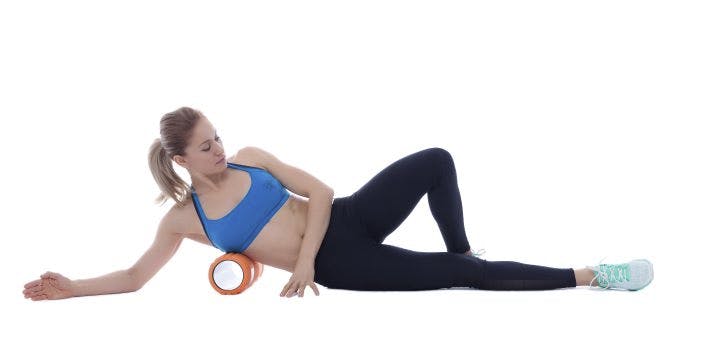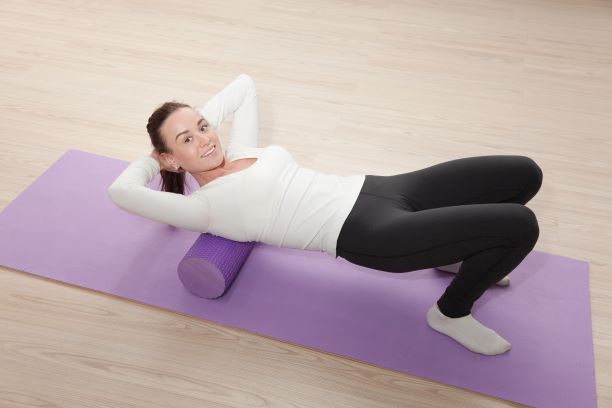Are you stretching your shoulders but not seeing any real improvement in your range of motion? Many people see little carryover or long-term change by doing stretching exercises alone. Manual therapy performed by your physical therapist provides an additional benefit to self-stretching. However, you can’t see your physical therapist forever. If you want to see greater improvements on your own, add foam roller exercises to your shoulder stretching routine.
The Science of Foam Rolling
The exact way foam rolling works is unclear. There are 3 primary theories. First foam rolling is believed to improve local blood flow to your muscles. This makes them easier to stretch. Second, some suggest it improves the mobility of your fascia. We are not convinced about this one. Fascia is the thin connective tissue that surrounds and holds your organs, blood vessels, bones, nerves, and muscles in place. It is questionable whether or not fascia restricts any range of motion. Finally, foam rolling may reduce the sensitivity of your nervous systems allowing tight muscles to relax. This one makes the most sense to us.

Even though the reason why foam rolling works is not known, we do know it helps improve range motion. At least, in the short term, foam rolling improves your range of motion for up to 30 minutes. The degree of improvement is variable between people. Some people will see no improvement. Others will see a 20% to 25% improvement.
It is best to perform 1–3 sets of rolling for each area before doing your stretching exercises. Combining foam rolling with stretching produces the best results. Each set lasts 30 to 120 seconds. We recommend closer to 30 seconds. While rolling, identify tight or tender areas. Apply sustained pressure to these areas for 2 to 4 seconds.
5 Foam Roller Exercises for Your Shoulder
Below are 5 foam roller exercises that will improve your shoulder mobility. You do not have to perform them all. Identify the 2 or 3 areas that are most limited or tender. Roll these areas for a few minutes then immediately perform your shoulder stretching exercises.
Foam Rolling Your Upper Back
Tightness in your thoracic spine and rib cage will limit your shoulder mobility. In order to raise your arms overhead, your upper back must be able to extend and rotate. Foam rolling this area will solve this problem.
Begin in a lying position over a foam roller. Place your hands behind your neck supporting, but not pulling on, your neck. Raise your buttocks off the ground and roll your upper back up and down the foam roller. Identify a sensitive, stiff, or tender area, and then drop your buttocks to the floor. From this position perform small extension movements by lifting your elbows up towards the ceiling. Be careful not to overextend your lower back.
Foam Rolling Your Lats
Your lat muscles span from your pelvis and low back all the way up to your armpit. Tightness in your lats will restrict your ability to reach over and behind your head. This is very common.
To roll your lats, lie on your side with the foam roller positioned in your armpit. Bend your bottom leg and straighten your top leg. Your palm is facing up to rotate your upper arm and apply a stretch to your lats. Engage your abdominals slightly to maintain a posterior tilt of your pelvis. Slowly roll up and down covering an area of about 6 to 12 inches. Gentle pressure is all that is needed. Aggressive pressure or foam rolling will increase tension in your lats.
Foam Rolling Your Thoracolumbar Fascia
Your thoracolumbar fascia is a thick broad band of connective tissue that spans from your pelvis and spine to your upper back. Your lats and several other major muscles attach to this large structure. Rolling this area is not the most comfortable. Start with light pressure for no more than 30-second sets.
Lie on your side with the foam roller positioned just above your hip. Slightly lean back so the foam roll contacts your backside. Bend your top and straighten your lower leg. Engage your abdominals slightly to maintain a posterior tilt. Slowly roll up and down covering an area of about 6 to 8 inches. Remember, use light pressure at first.
Foam Rolling Your Triceps
The long head of your triceps muscle crosses your shoulder joint. Therefore, restrictions in this muscle will limit your ability to reach overhead. Also, this is a tough muscle to stretch on your own. Foam rolling will help.
Get in a kneeling position with a bench or table in front of you. With your palm up, place the foam roller under your upper arm. Shift your weight back and forth to roll the back of your arm. Try bending a straightening your elbow to localize the pressure. Sustain the pressure over any tight or tender areas. You can even twist your arm to apply pressure more to the inside or outside of your arm.
Foam Roller Exercise for Your Pecs
Your pectoral muscles attach to your ribs, shoulder blade, and upper arm. Short pec muscles will pull your shoulder forward. In order for your arms to move overhead, your shoulder blade must tilt back and rotate. If it can’t you will be limited and place more stress on other structures around your shoulder.
This is more of a stretch than a rolling exercise. To stretch your pecs, lie on a foam roll longways so it rests between your shoulder blades. With your elbow bent allow your arms to fall down towards the floor. Fully exhale and relax in this position for 30 seconds. Do 3 stretches each day.
See Your Physical Therapist to Learn the Right Foam Roller Exercises for You
Foam rolling does not cause any strength, power, or speed performance deficits. Thus athletes can use a relatively wide selection of repetitions, and durations to improve the extensibility of their muscles and soft tissue without significant reduction in performance. This makes it a great tool to warm up with.
If you are unsure about foam roller exercises that are right for you, give us a call. Your physical therapist will help you design the best foam roller exercise and stretching program to help you achieve your goals.


